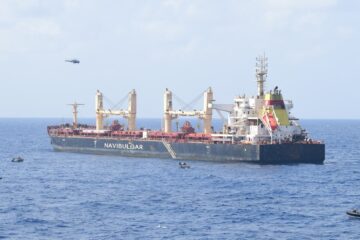The Indian Navy’s aircraft carriers, the Russian origin INS Vikramaditya (R33) and the indigenous INS Vikrant (R11), were on full display during the last week of February and the first week of March as the two carriers along with escorts conducted joint operations on multiple locations along the Indian coastline.
Both carriers conducted simultaneous launching of MiG-29K fighters in the first week of March, during which INS Vikramaditya was hosting the first half of Indian Navy’s Biannual Naval Commanders’ Conference 2024. The carriers also hosted and transported multiple journalists to cover the commissioning of the Navy’s latest base, INS Jatayu in Minicoy Island of the Lakshadweep archipelago off the south-western coast of mainland India.

The base has strategic significance due to its proximity to the Maldives, with which India recently has strained ties due to a newly elected anti-India administration in the island state. Minicoy island is eventually planned to get an airstrip and expand to support more substantial naval and air operations.
Earlier, the carriers had sailed to Visakhapatnam on India’s east coast and home to the Navy’s Eastern Naval Command for international exercise MILAN 2024. MILAN is a biennial exercise first held in 1995. The 2024 edition witnessed over 50 participating nations, 35 vessels and 50 aircraft. INS Vikramaditya berthed at Visakhapatnam for the first time, while it was Vikrant’s first visit to her eventual homeport. INS Vikrant sported its MFSTAR primary radar panels and MRSAM launchers, which were fitted in recent months at Cochin Shipyard Limited. These equipment were absent when the two carriers last sailed together in mid-2023.

At MILAN 2024, both carriers launched various sorties and participated in a group sail with ships and aircraft from Australia, Bangladesh, France, Indonesia, Iran, Japan, Malaysia, Mauritius, Myanmar, Russia, Seychelles, Sri Lanka, Thailand, U.S.A and Vietnam. Delegations from these nations, among multiple others, were also hosted onboard the carriers. It is notable that India’s Ministry of Defence had stated that there is export interest for the Vikrant carrier design.
The Indian Navy has long maintained that it requires three carriers for sustained operations, with a large CATOBAR equipped design being the eventual choice. However, the associated costs and technological maturity levels has seen the Navy seek a follow-on carrier based on the Vikrant. Discussions regarding this potential acquisition are still ongoing. This project as well as the development of a Twin Engined Deck Based Fighter (TEDBF) is also expected to be sanctioned in the coming years.
The Navy will meanwhile acquire up to 26 Dassault Rafale-M naval fighters from France to complement and partially replace the suboptimal MiG-29K fleet. A contract for the same is likely to be signed in the near future. The possibility of the Navy purchasing a few LCA-Navy aircraft for training purposes also remains open.
During the naval conference, the Indian defence minister had underscored the Indian Navy’s role as a net security provider in the Indian Ocean Region, especially in the backdrop of recent events around the Gulf of Aden. The highly publicised twin carrier operations are intended to highlight this role, even as India seeks to counter the ever-increasing naval presence of China in the region.






